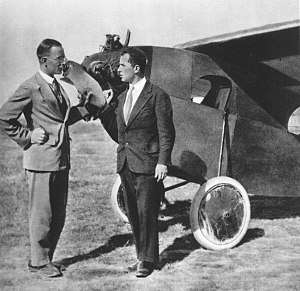RWD 7
The RWD 7 was a Polish sports plane of 1931, constructed by the RWD team.
| RWD 7 | |
|---|---|
 | |
| Jerzy Drzewiecki and Jerzy Wędrychowski by the RWD 7 | |
| Role | Sports plane |
| Manufacturer | Warsaw University of Technology workshops |
| Designer | RWD team |
| First flight | July 1931 |
| Introduction | 1931 |
| Retired | 1938 |
| Primary user | Polish civilian aviation |
| Number built | 1 |
Development
The RWD 7 was constructed by the RWD team of Stanisław Rogalski, Stanisław Wigura and Jerzy Drzewiecki in Warsaw. It was based upon their earlier designs, especially the RWD 2 and RWD 4. The RWD 7 was meant to be a record-beating plane, so it had a more powerful engine, while its mass was reduced. From its predecessors, it took the same fish-shaped fuselage without a direct view towards forward from the pilot's seat.[1]
The only RWD 7 built (registration SP-AGH) was flown in July 1931 by its designer Jerzy Drzewiecki. On August 12, 1931, Drzewiecki and Jerzy Wędrychowski established an international FAI speed record of 178 km/h (111 mph) in the light touring plane class, (below 280 kg / 616 lb empty weight).[1] On September 30, 1932, Drzewiecki and Antoni Kocjan set a height record of 6,023 m (19,755 ft). The RWD 7 was used in Warsaw Aero Club, among others, for aerobatics, then in 1936 it was bought by a known aviator Zbigniew Babiński for touring flights and used until 1938.[1]
The RWD 7 was known for its extremely short take-off run: with a single crew member only 18 m (59 ft), with two crew members, 30 m (98 ft).[1]
Description
The RWD 7 was a wooden construction, conventional in layout, high-wing cantilever monoplane. The fuselage was rectangular in cross-section (narrowing in upper part), plywood-covered, apart from the engine section, which was aluminium sheet-covered. The wings were trapezoid, single-spar, single part, canvas and plywood covered. A crew of two was sitting in tandem, with a pilot in the rear cab. The crew cabs were open on upper sides, and had doors on the right side. The engine was 5-cylinder Armstrong Siddeley Genet II radial engine, 56 kW (75 hp) nominal power. Two-blade wooden propeller of a fixed pitch. The plane had a conventional landing gear, with a rear skid. A 30 l fuel tank was in central part of wing. A cruise fuel consumption was 18 l/hour.[1]
Specifications
Data from Polskie konstrukcje lotnicze 1893–1939[1]
General characteristics
- Crew: 1
- Capacity: 1 / 194 kg (428 lb)
- Length: 9.8 m (32 ft 2 in)
- Wingspan: 6.3 m (20 ft 8 in)
- Height: 2 m (6 ft 7 in)
- Wing area: 13.6 m2 (146 sq ft)
- Empty weight: 246 kg (542 lb)
- Gross weight: 440 kg (970 lb)
- Powerplant: 1 × Armstrong Siddeley Genet II 5-cylinder air-cooled radial piston engine, 56 kW (75 hp)
- Propellers: 2-bladed fixed-pitch propeller
Performance
- Maximum speed: 186 km/h (116 mph, 100 kn)
- Stall speed: 65 km/h (40 mph, 35 kn)
- Range: 260 km (160 mi, 140 nmi)
- Service ceiling: 6,000 m (20,000 ft)
- Wing loading: 32 kg/m2 (6.6 lb/sq ft)
- Power/mass: 0.23 kW/kg (0.14 hp/lb)
- Take-off run: 18–30 m (59–98 ft)
References
| Wikimedia Commons has media related to RWD 7. |
- Glass, Andrzej (1977). Polskie konstrukcje lotnicze 1893–1939 (in Polish). Warsaw: WKiŁ. pp. 298–299.